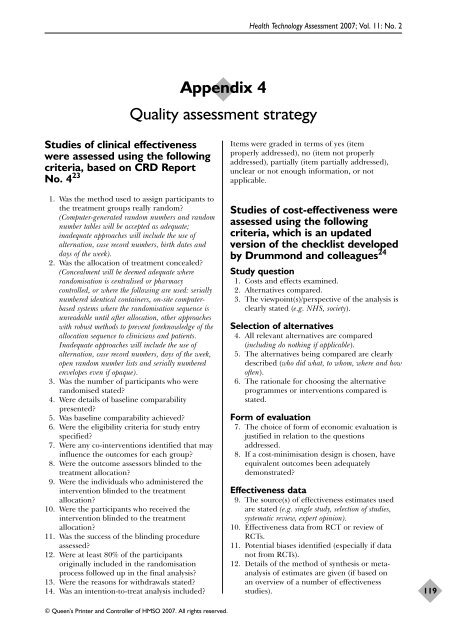Docetaxel with prednisone or prednisolone for the treatment of ...
Docetaxel with prednisone or prednisolone for the treatment of ...
Docetaxel with prednisone or prednisolone for the treatment of ...
Create successful ePaper yourself
Turn your PDF publications into a flip-book with our unique Google optimized e-Paper software.
Studies <strong>of</strong> clinical effectiveness<br />
were assessed using <strong>the</strong> following<br />
criteria, based on CRD Rep<strong>or</strong>t<br />
No. 4 23<br />
1. Was <strong>the</strong> method used to assign participants to<br />
<strong>the</strong> <strong>treatment</strong> groups really random?<br />
(Computer-generated random numbers and random<br />
number tables will be accepted as adequate;<br />
inadequate approaches will include <strong>the</strong> use <strong>of</strong><br />
alternation, case rec<strong>or</strong>d numbers, birth dates and<br />
days <strong>of</strong> <strong>the</strong> week).<br />
2. Was <strong>the</strong> allocation <strong>of</strong> <strong>treatment</strong> concealed?<br />
(Concealment will be deemed adequate where<br />
randomisation is centralised <strong>or</strong> pharmacy<br />
controlled, <strong>or</strong> where <strong>the</strong> following are used: serially<br />
numbered identical containers, on-site computerbased<br />
systems where <strong>the</strong> randomisation sequence is<br />
unreadable until after allocation, o<strong>the</strong>r approaches<br />
<strong>with</strong> robust methods to prevent f<strong>or</strong>eknowledge <strong>of</strong> <strong>the</strong><br />
allocation sequence to clinicians and patients.<br />
Inadequate approaches will include <strong>the</strong> use <strong>of</strong><br />
alternation, case rec<strong>or</strong>d numbers, days <strong>of</strong> <strong>the</strong> week,<br />
open random number lists and serially numbered<br />
envelopes even if opaque).<br />
3. Was <strong>the</strong> number <strong>of</strong> participants who were<br />
randomised stated?<br />
4. Were details <strong>of</strong> baseline comparability<br />
presented?<br />
5. Was baseline comparability achieved?<br />
6. Were <strong>the</strong> eligibility criteria f<strong>or</strong> study entry<br />
specified?<br />
7. Were any co-interventions identified that may<br />
influence <strong>the</strong> outcomes f<strong>or</strong> each group?<br />
8. Were <strong>the</strong> outcome assess<strong>or</strong>s blinded to <strong>the</strong><br />
<strong>treatment</strong> allocation?<br />
9. Were <strong>the</strong> individuals who administered <strong>the</strong><br />
intervention blinded to <strong>the</strong> <strong>treatment</strong><br />
allocation?<br />
10. Were <strong>the</strong> participants who received <strong>the</strong><br />
intervention blinded to <strong>the</strong> <strong>treatment</strong><br />
allocation?<br />
11. Was <strong>the</strong> success <strong>of</strong> <strong>the</strong> blinding procedure<br />
assessed?<br />
12. Were at least 80% <strong>of</strong> <strong>the</strong> participants<br />
<strong>or</strong>iginally included in <strong>the</strong> randomisation<br />
process followed up in <strong>the</strong> final analysis?<br />
13. Were <strong>the</strong> reasons f<strong>or</strong> <strong>with</strong>drawals stated?<br />
14. Was an intention-to-treat analysis included?<br />
Appendix 4<br />
Quality assessment strategy<br />
© Queen’s Printer and Controller <strong>of</strong> HMSO 2007. All rights reserved.<br />
Health Technology Assessment 2007; Vol. 11: No. 2<br />
Items were graded in terms <strong>of</strong> yes (item<br />
properly addressed), no (item not properly<br />
addressed), partially (item partially addressed),<br />
unclear <strong>or</strong> not enough inf<strong>or</strong>mation, <strong>or</strong> not<br />
applicable.<br />
Studies <strong>of</strong> cost-effectiveness were<br />
assessed using <strong>the</strong> following<br />
criteria, which is an updated<br />
version <strong>of</strong> <strong>the</strong> checklist developed<br />
by Drummond and colleagues 24<br />
Study question<br />
1. Costs and effects examined.<br />
2. Alternatives compared.<br />
3. The viewpoint(s)/perspective <strong>of</strong> <strong>the</strong> analysis is<br />
clearly stated (e.g. NHS, society).<br />
Selection <strong>of</strong> alternatives<br />
4. All relevant alternatives are compared<br />
(including do nothing if applicable).<br />
5. The alternatives being compared are clearly<br />
described (who did what, to whom, where and how<br />
<strong>of</strong>ten).<br />
6. The rationale f<strong>or</strong> choosing <strong>the</strong> alternative<br />
programmes <strong>or</strong> interventions compared is<br />
stated.<br />
F<strong>or</strong>m <strong>of</strong> evaluation<br />
7. The choice <strong>of</strong> f<strong>or</strong>m <strong>of</strong> economic evaluation is<br />
justified in relation to <strong>the</strong> questions<br />
addressed.<br />
8. If a cost-minimisation design is chosen, have<br />
equivalent outcomes been adequately<br />
demonstrated?<br />
Effectiveness data<br />
9. The source(s) <strong>of</strong> effectiveness estimates used<br />
are stated (e.g. single study, selection <strong>of</strong> studies,<br />
systematic review, expert opinion).<br />
10. Effectiveness data from RCT <strong>or</strong> review <strong>of</strong><br />
RCTs.<br />
11. Potential biases identified (especially if data<br />
not from RCTs).<br />
12. Details <strong>of</strong> <strong>the</strong> method <strong>of</strong> syn<strong>the</strong>sis <strong>or</strong> metaanalysis<br />
<strong>of</strong> estimates are given (if based on<br />
an overview <strong>of</strong> a number <strong>of</strong> effectiveness<br />
studies).<br />
119
















